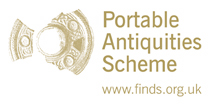File:Bronze Age socketed axe (plan, profile and plan). (FindID 610211).jpg

Original file (3,898 × 6,496 pixels, file size: 1.97 MB, MIME type: image/jpeg)
Captions
Captions
Summary
[edit]| Bronze Age socketed axe (plan, profile and plan). | |||
|---|---|---|---|
| Photographer |
Birmingham Museums Trust, Angie Bolton, 2014-04-07 20:28:59 |
||
| Title |
Bronze Age socketed axe (plan, profile and plan). |
||
| Description |
English: Bronze Age date (1150 - 800 BC) socketed axe: The copper alloy axe is a sub-trapezoid in plan. The mouth of the axe is sub square in plan with rounded corners, and on the mouth there is evidence of two casting jets, one on each side edge. The mouth, on the outer faces appears to be semi-circular in section and is slightly wider than the body of the axe itself. The surface of the socket is rough and is encrusted. There are also traces of what may be the casting residue. In profile the axe is triangular with a casting seam visible on both sides. There are no traces of a side loop. The body faces are undecorated and are trapezoidal in plan. The cutting edge is slightly convex, but it has the remains of the casting seam along it. The surface of the axe has traces of active corrosion, pitting and a well developed patina, but the majority of the surface is abraded and perhaps over cleaned revealing traces of fresh metal. It measures 57.76mm long, 36.32mm wide, 33.79mm thick and weighs 110.2g. The depth of the socket is 40.96mm deep.
Peter Reavill and Phil Watson comment the mouth of the axe is unusually wide, and that the shape is oddly 'stubby'. The blade has never been sharpened, and that in combination with the shape suggests it may have been made for use as a votive offering rather than a functional axe. It is probably dated to the late Bronze Age. As a note a similar shaped axe was recorded from the same parish which has similar dimensions, but does appear to be a functioning axe. |
||
| Depicted place | (County of findspot) Gloucestershire | ||
| Date | between 1150 BC and 800 BC | ||
| Accession number |
FindID: 610211 Old ref: WAW-1BF878 Filename: WAW-1BF878a.jpg |
||
| Credit line |
|
||
| Source |
https://finds.org.uk/database/ajax/download/id/463870 Catalog: https://finds.org.uk/database/images/image/id/463870/recordtype/artefacts archive copy at the Wayback Machine Artefact: https://finds.org.uk/database/artefacts/record/id/610211 |
||
| Permission (Reusing this file) |
Attribution-ShareAlike License version 4.0 (verified 25 November 2020) | ||
Licensing
[edit]- You are free:
- to share – to copy, distribute and transmit the work
- to remix – to adapt the work
- Under the following conditions:
- attribution – You must give appropriate credit, provide a link to the license, and indicate if changes were made. You may do so in any reasonable manner, but not in any way that suggests the licensor endorses you or your use.
- share alike – If you remix, transform, or build upon the material, you must distribute your contributions under the same or compatible license as the original.
File history
Click on a date/time to view the file as it appeared at that time.
| Date/Time | Thumbnail | Dimensions | User | Comment | |
|---|---|---|---|---|---|
| current | 17:59, 24 January 2017 |  | 3,898 × 6,496 (1.97 MB) | Fæ (talk | contribs) | Portable Antiquities Scheme, WAW, FindID: 610211, bronze age, page 1776, batch count 1650 |
You cannot overwrite this file.
File usage on Commons
The following page uses this file:
Metadata
This file contains additional information such as Exif metadata which may have been added by the digital camera, scanner, or software program used to create or digitize it. If the file has been modified from its original state, some details such as the timestamp may not fully reflect those of the original file. The timestamp is only as accurate as the clock in the camera, and it may be completely wrong.
| Width | 3,599 px |
|---|---|
| Height | 2,597 px |
| Bits per component |
|
| Compression scheme | Uncompressed |
| Pixel composition | RGB |
| Orientation | Normal |
| Number of components | 3 |
| Horizontal resolution | 300 dpi |
| Vertical resolution | 300 dpi |
| Data arrangement | chunky format |
| Software used | Adobe Photoshop Elements 2.0 |
| File change date and time | 22:12, 6 April 2014 |
| Exif version | 2.2 |
| Supported Flashpix version | 1 |
| Color space | Uncalibrated |
| Supported Flashpix version | 1 |
| Image width | 3,599 px |
| Image height | 2,597 px |
| Date and time of digitizing | 09:45, 29 April 2009 |
| Date metadata was last modified | 09:45, 29 April 2009 |
| IIM version | 2 |
